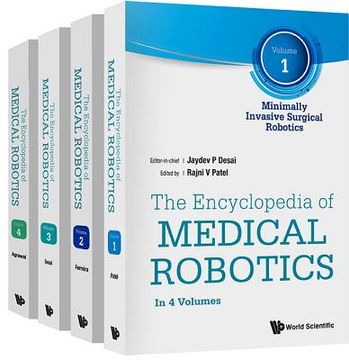Reseña del libro "Encyclopedia of Medical Robotics, the (in 4 Volumes) (en Inglés)"
The Encyclopedia of Medical Robotics combines contributions in four distinct areas of Medical robotics, namely: Minimally Invasive Surgical Robotics, Micro and Nano Robotics in Medicine, Image-guided Surgical Procedures and Interventions, and Rehabilitation Robotics. The volume on Minimally Invasive Surgical Robotics focuses on robotic technologies geared towards challenges and opportunities in minimally invasive surgery and the research, design, implementation and clinical use of minimally invasive robotic systems. The volume on Micro and Nano robotics in Medicine is dedicated to research activities in an area of emerging interdisciplinary technology that is raising new scientific challenges and promising revolutionary advancement in applications such as medicine and biology. The size and range of these systems are at or below the micrometer scale and comprise assemblies of micro and nanoscale components. The volume on Image-guided Surgical Procedures and Interventions focuses primarily on the use of image guidance during surgical procedures and the challenges posed by various imaging environments and how they related to the design and development of robotic systems as well as their clinical applications. This volume also has significant contributions from the clinical viewpoint on some of the challenges in the domain of image-guided interventions. Finally, the volume on Rehabilitation Robotics is dedicated to the state-of-the-art of an emerging interdisciplinary field where robotics, sensors, and feedback are used in novel ways to re-learn, improve, or restore functional movements in humans.Volume 1, Minimally Invasive Surgical Robotics, focuses on an area of robotic applications that was established in the late 1990s, after the first robotics-assisted minimally invasive surgical procedure. This area has since received significant attention from industry and researchers. The teleoperated and ergonomic features of these robotic systems for minimally invasive surgery (MIS) have been able to reduce or eliminate most of the drawbacks of conventional (laparoscopic) MIS. Robotics-assisted MIS procedures have been conducted on over 3 million patients to date -- primarily in the areas of urology, gynecology and general surgery using the FDA approved da Vinci(R) surgical system. The significant commercial and clinical success of the da Vinci(R) system has resulted in substantial research activity in recent years to reduce invasiveness, increase dexterity, provide additional features such as image guidance and haptic feedback, reduce size and cost, increase portability, and address specific clinical procedures. The area of robotic MIS is therefore in a state of rapid growth fueled by new developments in technologies such as continuum robotics, smart materials, sensing and actuation, and haptics and teleoperation. An important need arising from the incorporation of robotic technology for surgery is that of training in the appropriate use of the technology, and in the assessment of acquired skills. This volume covers the topics mentioned above in four sections. The first section gives an overview of the evolution and current state the da Vinci(R) system and clinical perspectives from three groups who use it on a regular basis. The second focuses on the research, and describes a number of new developments in surgical robotics that are likely to be the basis for the next generation of robotic MIS systems. The third deals with two important aspects of surgical robotic systems -- teleoperation and haptics (the sense of touch). Technology for implementing the latter in a clinical setting is still very much at the research stage. The fourth section focuses on surgical training and skills assessment necessitated by the novelty and complexity of the technologies involved and the need to provide reliable and efficient training and objective assessment in the use of robotic MIS systems.In Volume 2, Micro and Nano Robotics in Medicine, a brief historical overview of the field of medical nanorobotics as well as the state-of-the-art in the field is presented in the introductory chapter. It covers the various types of nanorobotic systems, their applications and future directions in this field. The volume is divided into three themes related to medical applications. The first theme describes the main challenges of microrobotic design for propulsion in vascular media. Such nanoscale robotic agents are envisioned to revolutionize medicine by enabling minimally invasive diagnostic and therapeutic procedures. To be useful, nanorobots must be operated in complex biological fluids and tissues, which are often difficult to penetrate. In this section, a collection of four papers review the potential medical applications of motile nanorobots, catalytic-based propelling agents, biologically-inspired microrobots and nanoscale bacteria-enabled autonomous drug delivery systems. The second theme relates to the use of micro and nanorobots inside the body for drug-delivery and surgical applications. A collection of six chapters is presented in this segment. The first chapter reviews the different robot structures for three different types of surgery, namely laparoscopy, catheterization, and ophthalmic surgery. It highlights the progress of surgical microrobotics toward intracorporeally navigated mechanisms for ultra-minimally invasive interventions. Then, the design of different magnetic actuation platforms used in micro and nanorobotics are described. An overview of magnetic actuation-based control methods for microrobots, with eventually biomedical applications, is also covered in this segment. The third theme discusses the various nanomanipulation strategies that are currently used in biomedicine for cell characterization, injection, fusion and engineering. In-vitro (3D) cell culture has received increasing attention since it has been discovered to provide a better simulation environment of in-vivo cell growth. Nowadays, the

